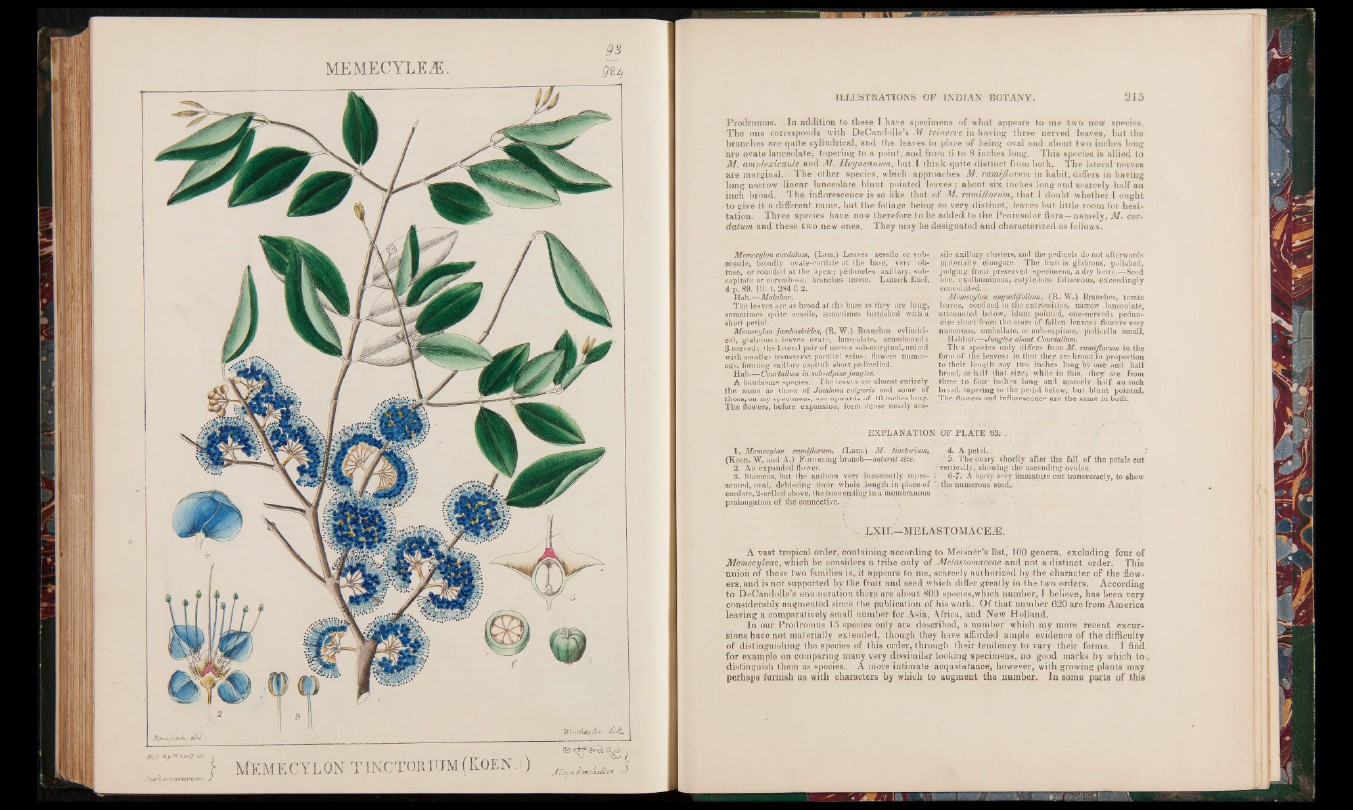
" I m em e cy l on t in c to r ium (Ko en . -•)
dio .
<V Go £ tn L_/.//— “S’ .
MEMECYLEiE.
Prodromus. Tn addition to these I have specimens of what appears to me two new species.
The one corresponds with DeCandolle’s M trinerve in having three nerved leaves, but the
branches are quite cylindrical, and the leaves in place of being oval and about two inches long
are ovate lanceolate, tapering to a point, and from 6 to 8 inches long. This species is allied to
M. ampleqicaule and M. Heynearium, but I think quite distinct from both. The lateral nerves
are marginal. The other species, which approaches M. ramiflorum in habit, differs in having
long narrow linear lanceolate blunt pointed leaves ; about six inches long and scarcely half an
inch broad. 'The inflorescence is so like that of M. ramiflorum, that I doubt whether I ought
to give it a different name, but the foliage being so very distinct, leaves but little room for hesitation.
Three species have now therefore to be added to the Peninsular flora—namely, M. cor-
datum and these two new ones. They may be designated and characterized as follows.
Memecylon cordatum, (Lara.) Leaves sessile or sub-
sessile, broadly ovate-cordate at the base, very obtuse,
or rounded at the apex; peduncles,axillaiy, sub-
capitate or corymbose, branches terete. Lamark Enel.
4 p. 89. 111. t. 2S4 f. 2.
Hab.—Malabar.
The leaves are as broad at the base as they are long,
sometimes quite sessile, sometimes furnished with a
short petiol.
Memecylon jambosioides, (R. W.) Branches cylindrical,
glabrous : leaves ovate, lanceolate, acuminated ;
3-nerved ; the lateral pair of nerves sub-marginal, united
with smaller transverse parallel veins: flowers numerous,
forming axillary capifuli short pedicelled.
Hab.-—Courtallum in sub-alpine jungles.
A handsome species. The leaves are almost entirely
the same as those of Jambosa vulgaris and some of
those, on my specimens, are upwards of 10 inches long.
The flowers, before expansion, form dense nearly ses-
EXPLANATION
1. Memecylon ramiflorum, (Lam.) M . tinctorium,
(Koen, W. and A.) Fiowerirtg branch—natural size.
2. An expanded flower.
3. Stamens, but the anthers very incorrectly repre-
sen ted, oval, dehiscing their whole „length in place of
cordate, 2 -celled above, the base ending in a membranous
prolongation of the connective. •
sile axillary clusters, and the pedicels do not afterwards
materially elongate. The fruit is glabrous, polished,
judging from preserved specimens, a dry berry.— Seed
one, exalbuminous, cotyledons foliaceous, exceedingly
convoluted.
Memecylon argustifolium, (R. W.) Branches, terate
leaves, confined to the extremities, narrow lanceolate,
attenuated below, blunt pointed, one-nerved; peduncles
short from the scars of fallen leaves; flowers very
numerous, umbellate, or sub-capitate, pedicells small.
Habitat.—Jungles about Courtallum.
This species only, differs from M. ramiflorum in the
form of the leaves; in that they are broad in proportion
to their length say two inches long by one- and half
broad, or half that size; while in this, they are from
three to four inches long and scarcely half an inch
broad, tapering to the petiol below, but blunt pointed.
The flowers and inflorescence are the same in both.
OF PLATE 93.- .
4. A petal. • ;
y- 5. The ovary shortly after the fall of the petals cut
vertically, showing th'e ascending ovules.
6-7- A berry very immature cut transversely, to show
the numerous seed.-
• LXIi:—MELASTQMACEA3.
A vast tropical order, containing'according to Meisiier’s list, 100 genera, excluding four of
Memecyleae, which he considers a tribe only of Melastomaceae and not a distinct order. This
union of these two families is, it appears to me, scarcely authorized by the character of the flowers,
and is not supported by the fruit and seed which differ greatly in the two orders. According
to DeCandolle’s enumeration there are about 800 species,which number, I believe, has been very
considerably augmented since the publication of his work. Of that number 620 are from America
leaving a comparatively small number for Asia, Africa, and New Holland.
In our Prodromus 15 species only are described, a number’ which my more recent excursions
have not materially extended, though they have afforded ample evidence of the difficulty
of distinguishing the species of this order, through their tendency to vary their forms. I find
for example on comparing many very dissimilar looking specimens, no good marks by which to-,
distinguish them as species. A more intimate acquaintance, however, with growing plants may
perhaps furnish us with characters by which to augment the number. In some parts of this